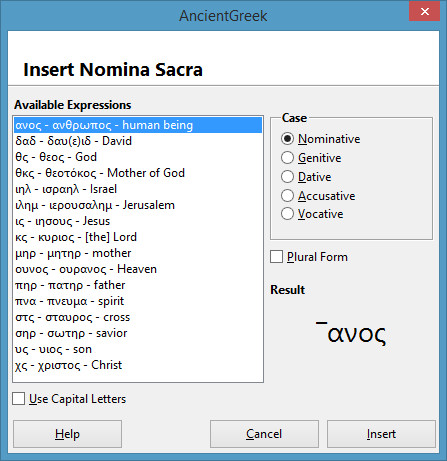Nomina Sacra Expressions
Ancient manuscripts were, of course, written by hand, often in large uncial scripts, on papyrus (moderately expensive) or parchment (even more expensive). The expense of writing materials and the time needed to copy a manuscript meant that every attempt had to be made to save space.
One way to conserve materials was abbreviations. A number of strategies were adopted at one time or another -- e.g. a superscript sigma at the end of a word, a bar representing a terminal nu, or a special symbol such as an elaborate script kappa for KAI.
The Christians went a step further by creating the nomina sacra ("sacred names"). These were abbreviations formed by taking the first one or two letters of certain words, plus the final letter(s) (to determine the inflection), omitting the intervening letters, and drawing a line over the whole.
The reason for the development of the nomina sacra is disputed and will not be covered here.
The use of nomina sacra became standard at a very early date. By the third century their presence or absence can be used to tell a Christian from a Jewish codex of the Old Testament. The use of the abbreviations at this time was slightly haphazard (e.g. one or two scribes might use the abbreviation IS for Joshua; in later use it would have been reserved exclusively for Jesus; similarly, should swthr be abbreviated if not used for Jesus?). One or two marginal abbreviations fluctuated in their use (e.g. the Egerton Gospel abbreviates profhtas). But by Byzantine times a list of sixteen nomina sacra had been generally adopted. They were as follows:
| English Meaning | Greek Word | Nominative (Subject) | Genitive (Possessive) |
|---|---|---|---|
| God | Θεός | ΘΣ | ΘΥ |
| Lord | Κύριος | ΚΣ | ΚΥ |
| Jesus | Ἰησοῦς | ΙΣ | ΙΥ |
| Christ/Messiah | Χριστός | ΧΣ | ΧΥ |
| Son | Υἱός | ΥΣ | ΥΥ |
| Spirit/Ghost | Πνεῦμα | ΠΝΑ | ΠΝΣ |
| David | Δαυὶδ | ΔΑΔ | |
| Cross | Σταυρός | ΣΤΣ | ΣΤΥ |
| Mother | Μήτηρ | ΜΗΡ | ΜΗΣ |
| Mother of God | Θεοτόκος | ΘΚΣ | ΘΚΥ |
| Father | Πατήρ | ΠΗΡ | ΠΡΣ |
| Israel | Ἰσραήλ | ΙΗΛ | |
| Savior | Σωτήρ | ΣΗΡ | ΣΡΣ |
| Human being | Ἄνθρωπος | ΑΝΟΣ | ΑΝΟΥ |
| Jerusalem | Ἱερουσαλήμ | ΙΛΗΜ | |
| Heaven/Heavens | Οὐρανός | ΟΥΝΟΣ | ΟΥΝΟΥ |
| Standard Nomina Sacra Expressions | |||
Nomina Sacra implementation ^
All Standard Nomina Sacra expressions can be inserted using AncientGreek, in all cases and forms (plural form when applicable).
Nomina Sacra expressions are inserted by preceding them with an Overline (‾) character (Unicode: U+230E, HTML: ‾). In case an Overline character should be inserted manually, one can type "8", select it and convert it from SPIonic to Unicode ("8" is the SPIonic code for Overline).
Presenting a Noamina Sacra expression using an Overline character may not always be dessirable. AncientGreek provides the way to convert them in an overlined form. So ‾ανος (Nomina Sacra expression for ἄνθρωπος) can be converted to ανος. And if that is not desirable anymore, it can always be converted back to the "overline form".
Nomina Sacra Macros ^
AncientGreek Nomina Sacra implementation have to do with inserting Nomina Sacra expressions and converting them in forms appropriate for editing documents. The macros responsible for these tasks are contained in modules modInsertNominaSacra and CharacterConversion.
• Insert Nomina Sacra dialog
When "Insert Nomina Sacra" is executed (through the AncientGreek Main dialog, Menu or Secondary Toolbar), the relevant dialog is displayed.

Insert Nomina Sacra dialog on Windows 8
The user can select the desired expression, set the Case and Plural Form (when applicable), and see the result, before pressing "Insert" to get the expression on the current cursor position of the document.
• Nomina Sacra Overlined Macro
All Nomina Sacra expresions inserted bt the "Insert Nomina Sacra" dialog are preceded by an Overline ( ‾ ) character. This macro will remove that character and overline the remaining expressions, throughout the document.
• Nomina Sacra with Overline character Macro
This macro will perform the opposite operation. It will remove the overline and precede the expressions with an Overline ( ‾ ) character, throughout the document.
AncientGreek text conversion macros can only work with the "overline form" of Nomina Sacra expressions. This means that Overlined Nomina Sacra expressions must be converted to "overline form" expressions before any text conversion takes place.
